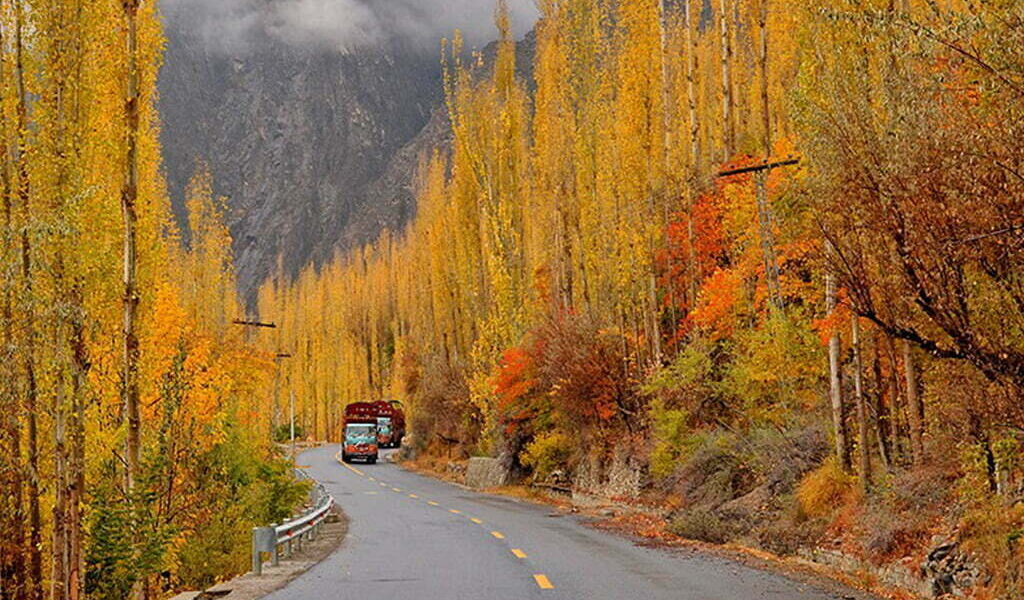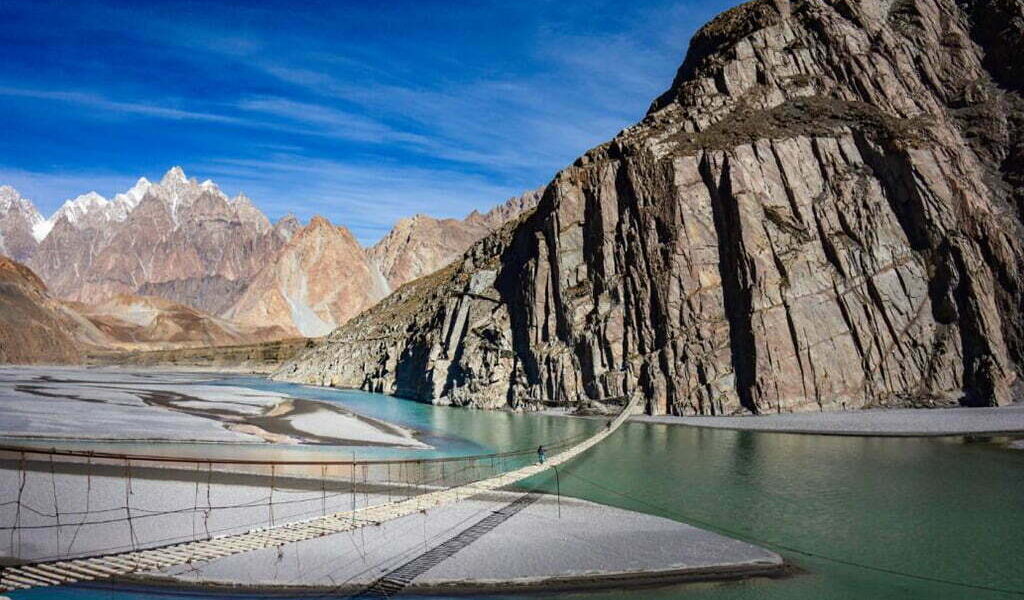Overview
TOUR BACKGROUND
The exceptional K2 Base Camp trek offers a glimpse of the native culture of Pakistan, as well as a visit to the excellent Baltoro Glacier and Concordia in the Karakoram Range. This trip will be an adventurous trip to the countryside and the surrounding villages by air and by road and trekking, discovering local life, captivating native Pakistan culture, and rocky landscapes along the way to K2 Base Camp adds in the beauty and joy of the trip.
K2 (8,611 meters) is the second-highest peak in the world and is located in Pakistan’s Karakoram mountain range. The Karakorum mountain range connects China, Pakistan, and India and it offers a natural barrier that is as unique as it is spectacular. Trekking to the base camp of K2 is one of a kind of journey that takes you to the top of the world where heaven and earth meet. K2 is a great mountain that is immense, wild, and beautiful which needs to be experienced to be believed.
During the K2 trip, you will get the opportunity to explore the ancient Himalayan kingdom of Baltistan and trek through the stunning areas of Skardu and Askole to reach the Karakoram Mountains. It is one of the world’s most distant areas and a true destination for adventurers and explorers. Trekking to base camp K2 provides a spectacular view of the local region and the Pakistani wilderness.
Hunza Adventure Tours has been operating adventure holidays in Pakistan for over 10 years,specializing in trekking and climbing expeditions. All our adventure holidays can be customized to suit your tastes and interests so you can experience a tailor-made adventure holiday and enjoy a K2 trek the way you want to.
Services Included
- Accommodation on twin sharing basis.
- Transportation for the whole trip.
- Well experienced guide.
- Hotel Meals.
- Airport Pick and Drop.
- Airport Pick and Drop.
- Portage at Hotels and Airport.
Itinerary
On arrival transfer the group to the hotel/ Guest House, in Rawalpindi Islamabad (the airport is situated mid-way between Islamabad and Rawalpindi). You will meet your guide in the afternoon at the hotel for a trip briefing and gear check.
a) Weather permitting; we take a spectacular flight to the high mountain region of Baltistan in the northeast. On a clear day, we should be able to see Nanga Parbat (8124m) and K2 (8611m) towering above all other mountains. (It is quite possible adverse weather in Islamabad or Skardu may affect our flight plans and make it necessary to drive by the Karakoram Highway to Skardu, a journey of approx. two days).
b) In case of cancellation of flight drive 10-12hrs by air-conditioned coach/car to Chilas (480km) on the Karakoram highway. Overnight at Shangri-La Indus View Hotel or Panorama hotel.
DETAILED
a) Overnight Masherbrum Hotel. Preparations for our trek and depending on our time of arrival into Skardu, there may be time to visit the town and possibly an excursion to Kachura Lake situated at the edge of the valley. Skardu is the regional capital of Baltistan, lying at the edge of a broad floodplain that is the confluence of the Shyok, Indus, and Basha Rivers.
b) If we are driving the road journey today will be 7-8 hrs. to Skardu (275km). On route are spectacular views of Nanga Parbat (8125m) overnight Hotel.
We will travel by jeep with our crew and supplies along the Shigar and Braldu valleys to Askole. Villages in Shigar have changed little in over five hundred years; farms with fields of barley, wheat, and vegetables surrounded by stone walls and stands of poplar, willow, and apricot trees. The apricot is a very important crop in the north, having a multitude of uses for the Baltit and Hunzakuts people. Villagers greet us as we pass through on the rugged dirt and stone road that leads to Baltoro. As we approach, the landscapes become desert-like, and once within the sheer valley of the Braldu, it is necessary to cross the river several times by suspension bridges. At various points, the road may have collapsed due to erosion and we will transfer the gear across on foot to a vehicle on the other side
After the considerable organization of equipment, supplies, and porter loads for the journey ahead, we commence trekking towards Jhola. The valley opens out to reveal the Biafo Glacier flowing for more than fifty kilometers from the Hispar La pass to the Braldu. We have our first taste of moraine walking as we cross the snout of the glacier and descend to our lunch spot beside the river. We also experience the harsh, stark environment that forms the base of these great mountains.
Our route takes us to the confluence of the Braldu and Dumordo Rivers where the infamous flying fox or ‘Jola’ is located. It is still there, however, a footbridge has now been built making the passage much easier from every perspective. (Consider individual passage of 50 to 70 people with loads, compared with walking straight across a steel bridge!). In past years it was necessary to make a high traverse across a rocky face and descend steeply to the riverside of the Dumordo to gain the flying fox. There is now a safe and pleasant pathway above the river. It is this valley, fed by the Panmah Glacier that was once a passage between Baltistan and Yarkand across the West Mustagh Pass (5370m) into China. Once across, we descend beside the river to the Braldu and then follow along its banks to our camp.
The route is mainly at riverside throughout the day, switching up and down somewhat according to the level of erosion and water levels of the Braldu. The Masherbrum Group may be glimpsed to our right via the Xiangang Valley. The range is a vast array of peaks that extend almost the full length of the southern side of Baltoro. Walking conditions are hot and dry and care must be taken to prevent sunburn, especially when most members will have come from a southern winter! As we approach camp several small glacially-fed rivulets flow down from the north and the first peaks of the Trango and Uli Biaho group appear on the distant ridgeline. The vast snout of the Baltoro glacier, the fourth-longest in Pakistan, is also visible but it’s hard to gather a sense of scale from here
An important preparatory stage for our crew and porters. Our goats are slaughtered and roti (bread) baked throughout the day for the journey ahead on the glacier. It is a welcome opportunity for us to relax, read and take photos. Perhaps do some washing and simply enjoy being in the mountains.
Making the short approach to the glacier, the great expanse of ice stretching across the Braldu comes into perspective when we see the many porters forming an ant-like trail across it. Ice cliffs tower more than sixty meters above the turbulent waters at the origin of the Braldu River. As a result of its continually changing nature, the glacial moraine may be difficult to trek upon at this stage and our route varies somewhat each time. One should be prepared for a hard day of walking and carry plenty of fluid. Once at the other side, the trail will hug the side and occasionally necessitate a glacier or river crossing. There are now uninterrupted views of Paiju Peak (6610m), Uli Biaho group, Trango Group, and Cathedral Group – a majestic, spired collection of mountains that the Karakoram is so well known for. Behind us, the steep grassy slopes make high grazing pastures for ibex and the rocks are home to mouse hares (Pikas) and colorful hoopoe birds which forage for food scraps.
An easier day’s walk, following a good trail at the side of the Baltoro with two feeding glaciers to cross en-route. It is Great Trango (5844m), facing eastwards, that is considered the greatest cliff face in the world and the point from which two Australians made a world record base jump in 1992. On the trail, pony trains carrying supplies to army camps are often passed and occasional helicopters overhead provide a reminder of our proximity to the disputed territory of Kashmir nearby. The grassy camp of Urdukas is well located before the mountains and is our last before continuing glacial camps. If the weather is clear at the head of the valley, we may see Broad Peak (8050m) and Gasherbrum IV (7930m), two of the most prominent peaks of the region.
Descending rugged terrain onto the glacier, we cross to the center where it is easier trekking.
We weave over rolling mounds of rock and scree, not unlike that of a quarry, and head almost in a direct path to GIV. We are in fact steering slightly northwards to a moraine hollow where Goro II is situated. The vast glacial highway of the Yermanendu feeds in from the south, leading from the many mountains around Biarchedi. Crystal and Marble Peaks are now right before us. Looking back towards Paiyu, the impressive mountain groups that have dominated our views over the last few days are now dwarfed as we trek higher and further away.
Services Included
- Accommodation on twin sharing basis.
- Transportation for the whole trip.
- Well experienced guide.
- Hotel Meals.
- Airport Pick and Drop.
- Portage at Hotels and Airport.
Services Excluded
- Hotel early check in and late check out.
- Extra days beyond the specified itinerary.
- Single supplement
- International flights, Airport and departure taxes and Visa fee and personal travel Insurance.
- Bottled water, aerated and alcoholic drinks. Items of a personal nature such as phone calls, laundry etc.
FAQ
We loves to customize personal trips for you, your friends, or organization. Our published land costs are typically based on number of individuals, so the number in your party may affect your land costs. Just give us a call/contact us and let us know what you’re interested in, and we’ll do our best to Make It Happen.
We are happy to help you arrange accommodations before and after your trip. We can recommend side excursions and restaurants for the extra time.
Our guide or representative will pick you up at the airport on the scheduled arrival date. We can help you arrange accommodations if you arrive earlier, and we are happy to make suggestions for transportation, restaurants and sightseeing.
All of our guides are highly skilled experienced professionals who have been selected based on their careful judgment, local knowledge, understanding of our client’s needs, patience and supportive guiding styles, and great personalities. In addition to their impressive personal achievements in the field, our guides bring a wealth of natural history, cultural anthropology and linguistic knowledge for their group’s enlightenment. Our international guides and staff surpass the needs of our clientele and make the trip enjoyable beyond expectations.
You will be greeted by our representative at airport on your arrival. He shall be holding a placard of your name for identification. We shall also provide you list of emergency 24 hours contact numbers for any emergency.
A complete clothing and equipment list specific to your trip will be sent to you in a dossier. Every year, after assessing feedback from our clients and guides, we review and update our lists so they are as complete and up-to-date as possible. Every list has a description of each item, however feel free to call us if you have questions or need help locating any of the items on the list. It is extremely important that you adhere strictly to the equipment list.
All accommodations are based on double or triple occupancy. If you are traveling solo and wish to share accommodations, we will pair you with another traveler of same gender. If you request single accommodations or a roommate cannot be assigned, you will be responsible for paying the single supplement fee.
Are there any restrictions for the Photography in Pakistan?
Pakistani people love to take pictures and photograph themselves !
Do not forget your camera !
Photography is a great fun in Pakistan as you will have enough sunlight most of the time. In some of the monuments one has to pay fee for the photography. Our guide will suggest you where it is worth to photograph and where not. At some of the locations photography is not allowed. It is prohibited to photograph military installations, which can include some the train stations, bridges and airports also.Do not photograph these objects otherwise your film can be confiscated.
Tipping is always a personal choice, but is greatly appreciated by your guides. Check your departure packet for details.










